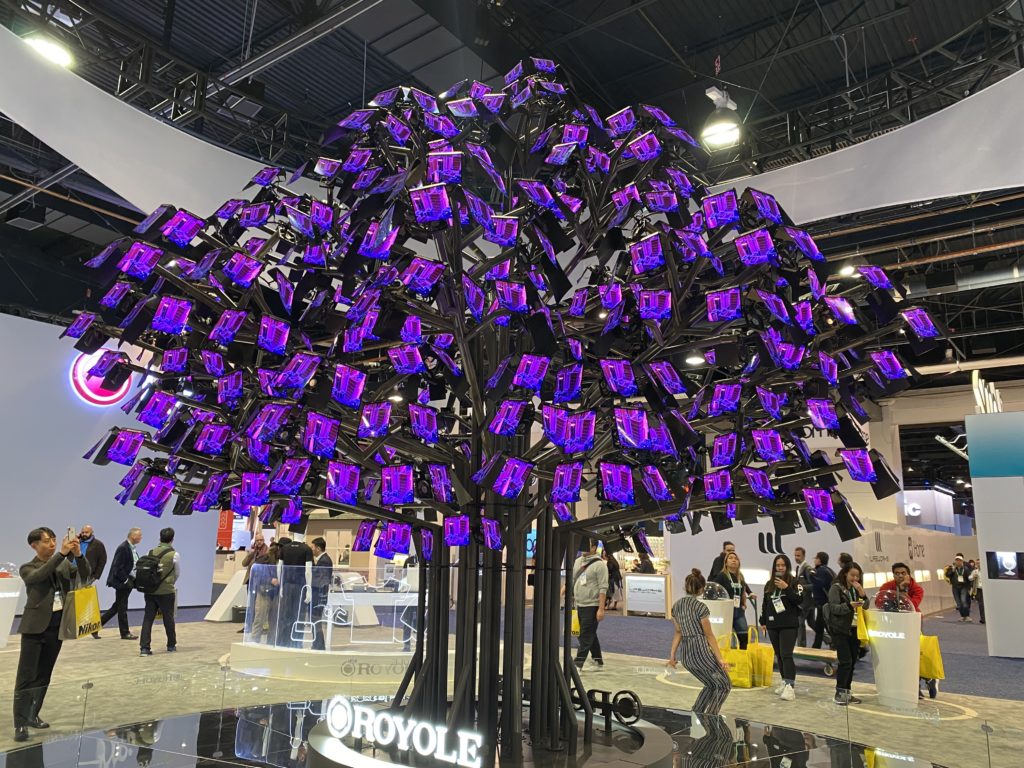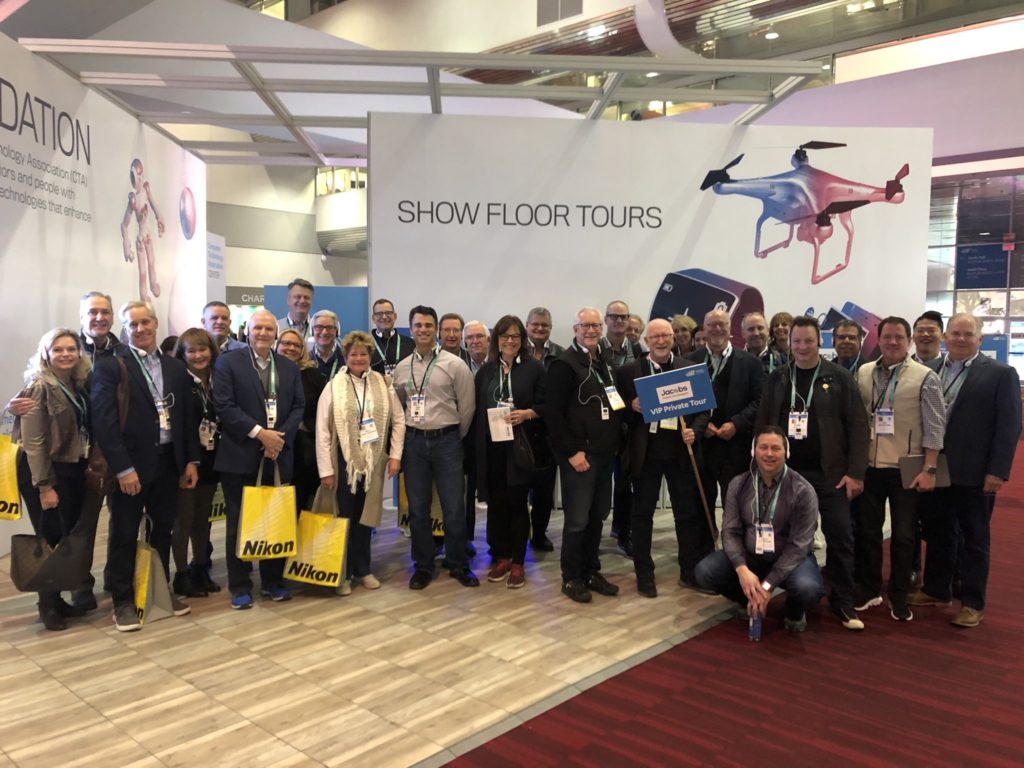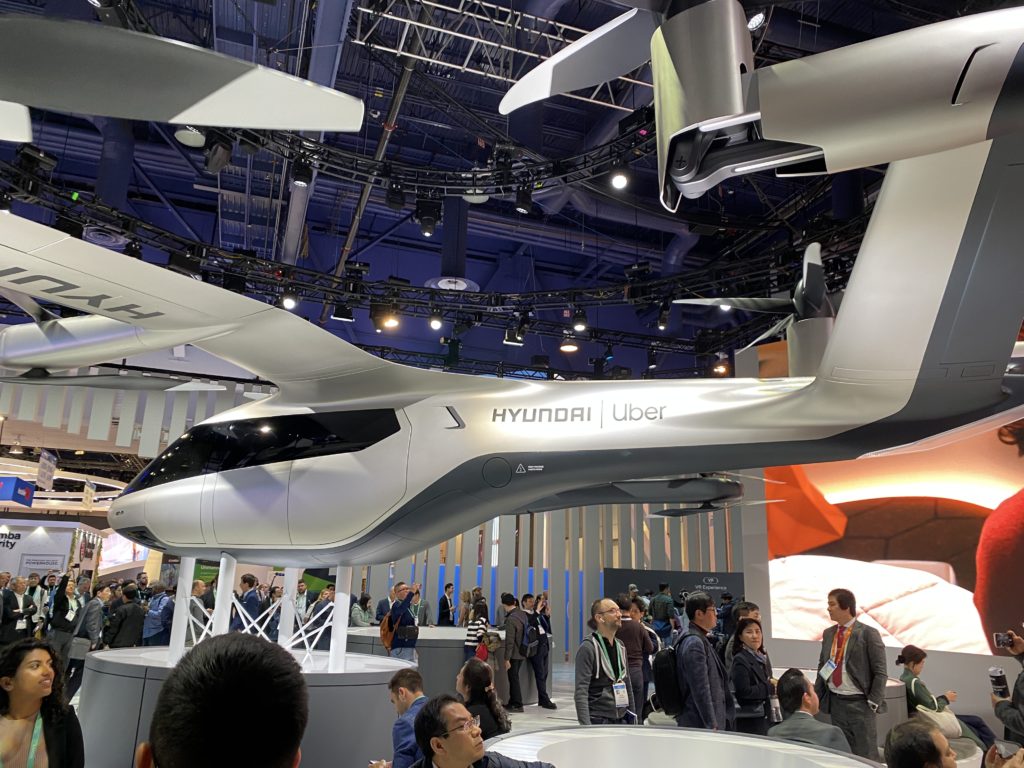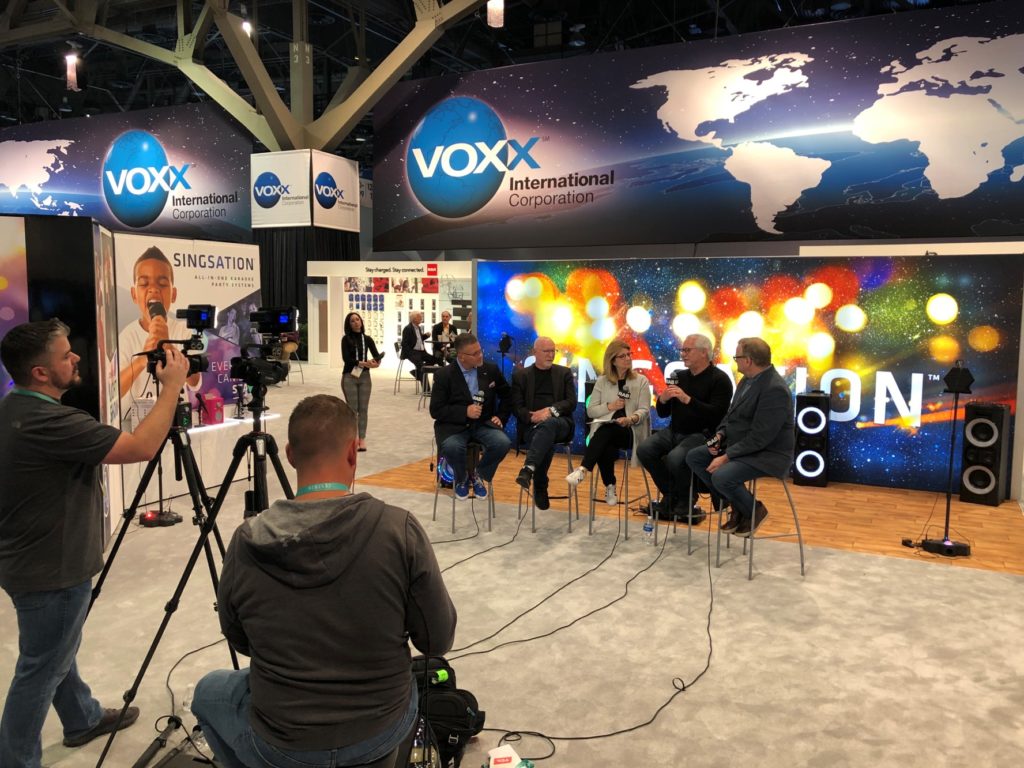
What a way to start a new year. Or a new decade.
Making the trek to Las Vegas for the first full week of 2020 is a tone-setter for the rest of the year. And once again, CES didn’t disappoint. That spirit of innovation, the size and scope of the event, and the truly collegial atmosphere among more than 180,000 attendees is what makes CES a very special event.
For CES 2020, a record 60+ broadcasters took part in our Jacobs Media tours – a great turnout. And whether at the Las Vegas Convention Center, Eureka Park, C Space, or the fast-growing GENIVI Alliance event, radio people were highly visible this year – a truly positive sign about what the industry is thinking.
 In short, it’s about seeing the future at the beginning of each calendar year. And this year was no exception. Paul and I were able to have breakfast with our mentor and fellow radio broadcaster, Philly’s Jerry Lee (pictured left). For Paul and me, it was our 12th consecutive CES. For Jerry, it was his 52nd annual trek, a perspective that none of us has. Jerry’s ability to process what he sees, hears, experiences, and feels at CES is a skill that’s acquired.
In short, it’s about seeing the future at the beginning of each calendar year. And this year was no exception. Paul and I were able to have breakfast with our mentor and fellow radio broadcaster, Philly’s Jerry Lee (pictured left). For Paul and me, it was our 12th consecutive CES. For Jerry, it was his 52nd annual trek, a perspective that none of us has. Jerry’s ability to process what he sees, hears, experiences, and feels at CES is a skill that’s acquired.
So, how was this year’s CES different, better, and more spectacular than in the past?
As I’ve reminded many of you in the past, please don’t ask me “What was the coolest gadget you saw at CES?”
For quite some time now, it has been less about a single innovation or gizmo, and more about how so much technology – AI, 5G, voice – is meshing together to create more seamless experiences. In fact, you come to realize that when you don’t notice the technology (think WiFi), that tells you it’s functioning well.
As noted, it takes a while for the holistic impact of CES to sink in. I was chatting with Erica Farber (the RAB co-hosts our CES Tour dinner). She has attended this event for several years now, and told me that this year, it all kicked in; she truly grasped the overriding effects of the technology and (perhaps most importantly), how it will impact our business. It takes time to inhale CES and begin to connect those dots.
So, today’s post, I’ll do my best to break it down for you, and as Publicis Groupe’s Tom Goodwin put it so eloquently in a recent commentary in The Drum, it’s about “finding clarity from the chaos of CES.”
And in my effort to do just that, it dawned on me that some of the biggest trends conveniently start with the letter “V.” So, here are five V’s to help put CES 2020 into context:

1. Voice – Yes, it’s been a key theme in the last two shows, but at CES 2020, it was less about those cylindrical or hockey puck shaped gadgets that have proliferated in our homes these past couple years. It IS much more about how voice has become the fuel that makes it easier to use so many different technologies in our homes, workplaces, and now, of course, our cars.
Everywhere you looked at CES, Google and Amazon were ominpresent, not just with their own proprietary displays, but with partnership arrangements with many, many brands and the gadgets they make. Jump-suit wearing Google Assistants were once again all over CES. working with myriad companies and brands that now power their gadgetry with Google Voice.
 Similarly, Amazon Alexa is becoming more ubiquitous at CES. Two years ago, their display was a modest Airstream trailer in the Central Plaza parking lot. This time around, Amazon showed it’s as serious as a hard attack when it comes to embedding its voice technology in our cars and trucks. Their impressive exhibit in the North Hall coexisted beautifully with the car manufacturers and their many Tier 1 suppliers.
Similarly, Amazon Alexa is becoming more ubiquitous at CES. Two years ago, their display was a modest Airstream trailer in the Central Plaza parking lot. This time around, Amazon showed it’s as serious as a hard attack when it comes to embedding its voice technology in our cars and trucks. Their impressive exhibit in the North Hall coexisted beautifully with the car manufacturers and their many Tier 1 suppliers.
Among other things, Amazon was touting the presence of Alexa in new Cadillacs, as well as a the announcement of a brand new partnership with Italian sports car maker Lamborghini (above left). I asked Arianne Walker, Amazon’s Chief Evangelist for Alexa Automotive, whether a shout-out to Alexa to “Play Z100” while driving in midtown Manhattan in one of these vehicles will pull up the station from the car’s tuner or from a streaming service like TuneIn (that way it works in Amazon Echo and Dots).
She explained that Amazon’s Alexa SDK (software developer kit) provides car manufacturers with a full range of options for installing their voice software into their dashboards. When it comes to those details, Amazon is agnostic.
That translates to this: Alexa will utilize the tuner to find a local station if an automaker decides it will do so. Or not. It is Ford’s (or GM’s or Toyota’s, etc.) option, something I know the NAB and other radio broadcasters are well aware of. It has become less about which apps are populated on a car’s touchscreen, and much more about which “voice” will respond to our commands.
Will there be pushbutton presets in cars of the future? Many of the auto execs I queried believe there will likely still be tactile buttons for making entertainment and information decisions. But more and more, we’ll be shouting out these commands about what to do with our ears – and our eyes – in our cars with our voices.
2. Video – It’s everywhere, and while we’ve become used to seeing amazing screens, curved glass screens, and perfect images, CES 2020 seemed even more focused  on visuals – in all settings. In past years, we saw audio make its move. While audio products were all over the Las Vegas Convention Center, video was far more front and center.
on visuals – in all settings. In past years, we saw audio make its move. While audio products were all over the Las Vegas Convention Center, video was far more front and center.
Both Samsung and LG envision video monitors becoming frames for downloadable art work. Royole (pictured right) is featuring an array of curved glass applications for homes and car dashboards. And wouldn’t you know it, that beautiful concept car introduced by Byton at CES 2018 has become a reality, hitting the market later this year.
Its curved dashboard offers infinite entertainment and information – but no signs of a radio per se. That’s where Xperi comes in. They are a proud partner for the Byton media set.
But the question we heard again and again revolves around what will be the source of video entertainment drivers – and passengers – will consume in standard and autonomous cars in the future?
While there may be fewer cars on the road in the coming years – thanks to autonomous commuting and ride sharing services – the “passenger economy” will become an increasingly more important factor in how media outlets, car companies, and other partners monetize passengers and occupants.
While audio has been a big star at CES these past couple years, it sure seemed like video jumped right back to the head of the class. And it sure feels like broadcast radio will need to commit to a stronger video presence in order to remain front and center in cars – and in the minds and hearts of the audience.
3. Value proposition – In essence, this is the one thing that everyone at CES is in search of. And it’s often elusive, whether you’re Amazon or a fledgling inventor showing off your “innovation” in Eureka Park.
It’s about asking the difficult question: What does your gadget, technology, or innovation do to simply and better my life? Apply that question to just about everything you see at CES, and you’ve got a pretty good litmus test for determining whether you’re product or service matters. Does it transcend other technologies and content offerings? Or is it simply duplicated by so many other better financed and marketed companies? And then this: Has it fallen behind these fast-moving times, no longer providing a unique and desirable service.
 I know these are questions our many of our Jacobs Media tour attendees asked themselves again and again about the myriad things they saw at CES. And most probably got around to considering them for the broadcasting industry – specifically, radio.
I know these are questions our many of our Jacobs Media tour attendees asked themselves again and again about the myriad things they saw at CES. And most probably got around to considering them for the broadcasting industry – specifically, radio.
Crafting a product that succeeds mostly in optimizing Nielsen ratings doesn’t mean doodly-squat under the bright lights of CES. Setting more occasions, growing cume among 25-54 year-old adults, or geo-locating that one errant meter has no value at CES. In fact, most of those endeavors stack up as negatives in the rapidly moving ecosystem we immersed ourselves in last week in Vegas.
Radio broadcasters – at all levels – have to rethink, redefine, and perhaps reshape their value propositions in a world where there are infinite, personalized choices, accessible by uttering a few words or making simple hand gestures. CES isn’t just about chasing the “new new thing.” Its about determining how existing products, services, and brands hold up in an increasingly more competitive landscape populated by discriminating consumers.
That’s exponentially more difficult than voicetracking middays, scheduling tomorrow’s log, or reforecasting Q1.
4. Victrola – There’s a brand name you probably haven’t encountered before, but it’s likely your grandparents (or even great grandparents) have. The company was formed in 1914, and the Victrola name became synonymous with a phonograph, in much the same way Kleenex means facial tissue, Frigidaire was what people called refrigerators, Xerox became photocopying, and Google is how we often refer to search.

The people talked to at Victrola’s spacious exhibit space in the Central Hall insisted they’ve been in business all this time. But if you simply haven’t heard this brand in the context of vinyl and turntables, you’re in good company.
But there they were at CES, with very retro-looking devices that played record albums, tuned in AM/FM radio stations, but also provided Bluetooth connectivity with digital hardware and software. Still, their traditional, nostalgic strategic position put them in good company at CES. A bevy of brands – Crosley, RCA, Hello Kitty – and many others were marketing in-home devices with throwback designs.
In fact, the boombox may have been the most ubiquitous look at the convention. Company after company were displaying audio devices of many types and features, many of which looked like bigboom boxes left over from the 60’s and 70’s. And some even included cassette players, which many believe is the beginning of a “new” trend in audio.
5. Vision Avatar – Perhaps I misspoke at the beginning of today’s blog post. There actually was one gadget – in this case, a concept car – that was the buzz of CES. (It’s pictured at the top of today’s post).
In fact, more and more people were talking about this truly jaw-dropping mashup of an imaginative film (James Cameron’s “Avatar”), an amazing futuristic vehicle dreamed up by Mercedes, and an immersive environment that was Ground Zero at CES. It had to be the most photographed, videoed, and talked about innovation. In fact, Mercedes was trending on Twitter, thanks to this car, and the innovative way they displayed it, with bigger than life music, sounds, and lights.
And unlike concepts you see at auto shows or tech gatherings like CES, the people we spoke to at Mercedes didn’t seem to care whether this vehicle ever get manufactured. To them, it’s about the confluence of technology, the world around us, and an exiting future they hoped captivated attendees last week.
It worked.

Of course, not everything cool and important at CES 2020 started with the letter “V.” Other key trends included brand partnerships, autonomous cars, smart cities and 5G, drones (like the air taxi for Hyundai and Uber above), personalizaiton, robots, and of course, “hearables” and headphones.
Brands were all over C Space at the Aria once again, while Eureka Park in the Sands continued to showcase more than 1,100 bootstrap inventors from around the planet.
We’ll be exploring it all, what these trends mean to broadcast radio, as well as our annual “Worst of Show” awards, in a free webinar set for Tuesday, January 28th at 2pm ET, in partnership with our friends at Inside Radio. We’ll break down the key trends at CES 2020, and what they mean to broadcast radio this coming year – and beyond.
You can register for the webinar here.
Also coming up, our CES 2020 RAB wrap-up, a 30-minute conversation about CES, broadcast radio, and what it all means. Watch for notification from the RAB.

- Can Radio Win “The Last Touch/First Touch Challenge?” - April 4, 2025
- How Will Radio Fare In The Battle For The Fourth Screen? - April 3, 2025
- Like A Pair Of Old Jeans - April 2, 2025




Paul, agreed: “it sure feels like broadcast radio will need to commit to a stronger video presence in order to remain front and center in cars – and in the minds and hearts of the audience”
As video is a key driver in the signals Google utilizes to rank websites, a collective, industry brainstorming effort – where no idea is evaluated until the clock runs out or the idea flow stops – can help us identify new opportunities. It’s just a matter of someone with the breadth of industry contacts doing the execution.
The objective is generating these brainstormed ideas for video, in identifying and creating a more profitable, continuous, self-amplifying, and self-sustaining, community-focused experience; doing so for the concurrent benefit of your market’s constituents (not just your audiences), your advertisers and your companies.
Good thoughts, Andy. Video is an opportunity for the radio business, not to mention where the puck is moving/has moved.
From high-tech food to folding computers to upgrading your health to a prototype city of the future, these trends mattered. This story is part of CES 2020, our complete coverage of the showroom floor and the hottest new tech gadgets around.